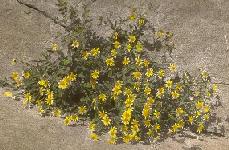
Photo by Charles Webber.

Photo by Charles Webber.
Clasping Arnica
(Streambank Arnica)
Arnica amplexicaulis Nutt.
It is a fairly attractive perennial with several to many upright stems arising from 30-80 cm high from freely rooting rhizomes. The herbage of the stems is more or less hairy and glandular. The stems are noticeably leafy with 5-12 pairs of opposite leaves which are relatively the same size along the whole stem. Individual leaves are narrowly lance-elliptic to lance-ovate in shape with either short petioles on the lower leaves to lacking petioles on the upper leaves. The leaves range from 5-12 cm long and 1.2-6 cm wide and have toothed margins Bright small yellow flowers with outer rays and inner disk flowers. The 8-14 yellow rays are 1-2 cm long and surround a yellow central disk. Blooms in May through July. Found in lodgepole or subalpine forests may be found in both wetlands and non wetlands. Most frequently grows in rather dry, gravelly soils of sagebrush communities, in regions of cold winters and moist springs. Grows at elevations between 7,000 and 10,000 feet. Widely distributed in southeast Idaho particularly in the vicinity of the Bear River Range.
WARNING: Arnica should be only used with extreme care. Arnica may cause contact dermatitis (inflammation of the skin, especially in allergy-prone persons) when used externally, and complete collapse when taken internally. Therefore, Arnica is subject to legal restrictions in many countries.
Medicinal Uses:
Arnica is restricted for
external use only in the USA. Externally Arnica may be used in liniments
or creams for for sunburn, superficial and
limited burns, bruises, sprains, swollen feet, dislocations,
sprains, bruises, chilblains and varicose ulcers.
Arnica has a long history of herbal use, especially as an
external treatment for bruises and sprains. It is an ingredient of a number of
proprietary preparations. Internally, it has been used in the treatment of heart
complaints and as a booster for the immune system. Arnica increases local blood
supply and accelerates healing, it is anti-inflammatory and increases the rate
of absorption of internal bleeding. Generally the plant is nowadays only
recommended for internal use as a homeopathic medicine, principally for treating
shock, injury and pain.
Planting:
Seed is best sown as soon as it is ripe in pots outdoors. Sow stored seed in
early spring in a cold frame. A period of cold stratification is helpful. The
fresh seed can germinate in 3 - 4 weeks at 13°c according to one report, though
it can be slow, difficult and erratic and take 2 years to germinate. Prick out
the seedlings into individual pots when they are large enough to handle and
plant them out into their permanent positions in the following spring. Division
in spring